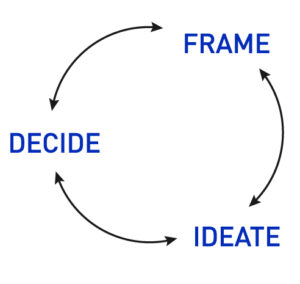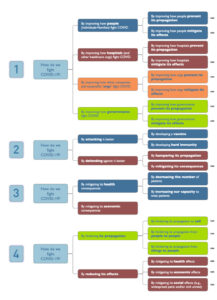
Method in the madness: organizing information flows
Combatting COVID-19 is fast becoming the greatest challenge of our time. While we don’t yet know exactly what it will take to succeed, a wealth of knowledge exists from around the world that is ripe for the picking.
But how can we organize that information to extract viable solutions? We have spent the past several years creating highly versatile methodologies to solve complex problems that are not only apt for fighting COVID-19, but also applicable across all disciplines.
Easy as one, two, three
Solving complex problems is a three-step process: frame, ideate and decide (Figure 1).
When framing, you decide what the problem is and equally important, what it isn’t. You then summarize this in a situation–complication–question sequence, that gets to the essence of the
problem.
In the ideating phase, you brainstorm alternative answers — options — to your key question. Here, drawing an option map can help you expand and organize the universe of possibilities.

In the last step, you consider what is important in the options — your criteria — and rate them on each criterion. This helps you identify which option offers the best tradeoffs.
When it comes to the framing and deciding steps of the fight against COVID-19, it isn’t necessary to reach a consensus among all stakeholders. Which is good news, considering the sheer amount of people affected by the illness worldwide. However, harnessing the wisdom of such a large crowd can be particularly helpful in ideating.
Ideas to fight COVID-19 are surfacing across the globe but remain unknown to other people who might also benefit from them. For instance, after reading that a startup in Italy was using 3D printing to make ventilators, someone in another country asked how he could help local hospitals using his own 3D printer. Organizing and concentrating knowledge can be useful, and that’s exactly what an option map can do.
To record this knowledge, we asked people for ideas and organized them into a map (see Figure 2). Our efforts are ongoing and the process is challenging, but immensely rewarding.
Gaps, overlaps and option maps
Good option maps obey four rules: they answer a single type of question, proceed to potential options, contain mutually exclusive (ME) and collectively exhaustive (CE) branches, and are insightful. The first two are reasonably straightforward but the last two rules make the exercise difficult.
A map that abides by these rules will have no gaps or overlaps in its structure and it will be organized in a way that is both correct and valuable.

Much of the value of an option map hinges on its very first breakdown, what we call the first cut, where the initial answers to the question appear. More than any other, the first cut is particularly critical, because it affects 100% of the map.
To assess the value of a first cut — or, for that matter, breakdowns at any level — you have to ask if the structure is ME, CE and insightful.
Assessing ME-ness and CE-ness is an absolute: either the breakdown is MECE or it isn’t. To test this, relentlessly attack the logic of the breakdown by looking for logically valid answers that are duplicated (a violation of ME-ness) or find some that should be there but aren’t (a violation of CE-ness).
Insightfulness, however, is a relative property. Before determining if a breakdown is insightful, you must compare it to another possible breakdown and then identify which of these two would be most useful.
A map for fighting COVID-19
In the case of our COVID-19 map, we identified four possible first cuts:
Number 1 organized the map by actors: who (people, hospitals, other organizations and governments) can do what.
Number 2 organized the map by the type of combative actions we can take: attacking COVID-19 or defending against it.
Number 3 organized the map by how we mitigate COVID-19’s health and economic consequences.
Number 4 organized the map by other types of combative actions we can take: hinder its propagation or reduce its effects.
Next, we needed to identify which of these four we wanted to use to start our map. Fairly quickly, it became apparent that Number 3 didn’t work because it wasn’t collectively exhaustive. Indeed, mitigating COVID-19’s effects is one type of possible action, but it doesn’t include all the actions we could take, such as preventing its propagation.
The second option — attacking COVID-19 and defending against it — was worthwhile at first but soon became too elaborate as the map developed further. For instance, does “not wearing the same clothes inside and outside of one’s house” belong to the offensive or the defensive branch? With these uncertainties, we eliminated Number 2.
That left us with candidates 1 and 4. Number 1 was initially attractive because it separates what the various types of actors can do. We used it to organize the first versions of the map, which we then circulated to the wider community for input.
However, this structure quickly became convoluted as new ideas surfaced. For example, “developing vaccines” would belong to the branches of three of the four actors (hospitals, other organizations and governments can all develop vaccines). This isn’t a violation of the rules, but the map felt clunky, so we looked for something else.
Three days into the effort, we thought about Number 4: hindering COVID-19’s propagation and reducing its effects. It took several hours to develop, but, despite this structure’s intricacies, it has enabled us to map the set of options in the cleanest way. For the moment, we have a winner.
Adapt, adapt and adapt again
This iterative process is standard in developing option maps — it’s rare to create an excellent map structure on your first attempt. The process will be challenging, so set aside enough time and energy for your efforts.
You must also update your thinking in light of new evidence. And if the new evidence shows there’s a better structure than the one you’ve been using, adapt! New evidence can, and must, be incorporated when it becomes available.
Along our journey to create a methodology for problem solving, we have relied on ideas and contributions from people around the world. To refine our applications of problem-solving tools to fight COVID-19, amongst other problems, we invite you to share your ideas here.
Working individually won’t halt the pandemic. But by sharing ideas, working together and using appropriate tools, we can glean insights that would not otherwise be evident. Complex problems have no trivial solutions, and our versatile methodology for problem solving is the first step in developing a successful response.
Research Information & Knowledge Hub for additional information on IMD publications
Last week, a notification flashed. “Add your email address for extra security,” my phone chirped. It was from WhatsApp. I stared at the screen, a single question forming in my mind: Security? Or surveillance? I tapped “No.” The feeling wasn’t ange...
Research Information & Knowledge Hub for additional information on IMD publications
Research Information & Knowledge Hub for additional information on IMD publications
Research Information & Knowledge Hub for additional information on IMD publications
in I by IMD
Research Information & Knowledge Hub for additional information on IMD publications
Research Information & Knowledge Hub for additional information on IMD publications
Research Information & Knowledge Hub for additional information on IMD publications
Research Information & Knowledge Hub for additional information on IMD publications
in I by IMD
Research Information & Knowledge Hub for additional information on IMD publications
Research Information & Knowledge Hub for additional information on IMD publications
Research Information & Knowledge Hub for additional information on IMD publications







